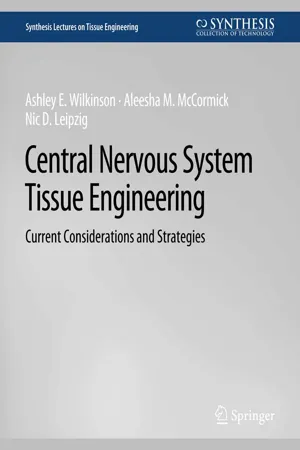
eBook - PDF
Central Nervous System Tissue Engineering
Current Considerations and Strategies
- English
- PDF
- Available on iOS & Android
eBook - PDF
Central Nervous System Tissue Engineering
Current Considerations and Strategies
About this book
Combating neural degeneration from injury or disease is extremely difficult in the brain and spinal cord, i.e. central nervous system (CNS). Unlike the peripheral nerves, CNS neurons are bombarded by physical and chemical restrictions that prevent proper healing and restoration of function. The CNS is vital to bodily function, and loss of any part of it can severely and permanently alter a person's quality of life. Tissue engineering could offer much needed solutions to regenerate or replace damaged CNS tissue. This review will discuss current CNS tissue engineering approaches integrating scaffolds, cells and stimulation techniques. Hydrogels are commonly used CNS tissue engineering scaffolds to stimulate and enhance regeneration, but fiber meshes and other porous structures show specific utility depending on application. CNS relevant cell sources have focused on implantation of exogenous cells or stimulation of endogenous populations. Somatic cells of the CNS are rarely utilized for tissue engineering; however, glial cells of the peripheral nervous system (PNS) may be used to myelinate and protect spinal cord damage. Pluripotent and multipotent stem cells offer alternative cell sources due to continuing advancements in identification and differentiation of these cells. Finally, physical, chemical, and electrical guidance cues are extremely important to neural cells, serving important roles in development and adulthood. These guidance cues are being integrated into tissue engineering approaches. Of particular interest is the inclusion of cues to guide stem cells to differentiate into CNS cell types, as well to guide neuron targeting. This review should provide the reader with a broad understanding of CNS tissue engineering challenges and tactics, with the goal of fostering the future development of biologically inspired designs.
Table of Contents: Introduction / Anatomy of the CNS and Progression of Neurological Damage / Biomaterials for Scaffold Preparation / Cell Sources for CNS TE / Stimulation and Guidance / Concluding Remarks
Frequently asked questions
Yes, you can cancel anytime from the Subscription tab in your account settings on the Perlego website. Your subscription will stay active until the end of your current billing period. Learn how to cancel your subscription.
At the moment all of our mobile-responsive ePub books are available to download via the app. Most of our PDFs are also available to download and we're working on making the final remaining ones downloadable now. Learn more here.
Perlego offers two plans: Essential and Complete
- Essential is ideal for learners and professionals who enjoy exploring a wide range of subjects. Access the Essential Library with 800,000+ trusted titles and best-sellers across business, personal growth, and the humanities. Includes unlimited reading time and Standard Read Aloud voice.
- Complete: Perfect for advanced learners and researchers needing full, unrestricted access. Unlock 1.4M+ books across hundreds of subjects, including academic and specialized titles. The Complete Plan also includes advanced features like Premium Read Aloud and Research Assistant.
We are an online textbook subscription service, where you can get access to an entire online library for less than the price of a single book per month. With over 1 million books across 1000+ topics, we’ve got you covered! Learn more here.
Look out for the read-aloud symbol on your next book to see if you can listen to it. The read-aloud tool reads text aloud for you, highlighting the text as it is being read. You can pause it, speed it up and slow it down. Learn more here.
Yes! You can use the Perlego app on both iOS or Android devices to read anytime, anywhere — even offline. Perfect for commutes or when you’re on the go.
Please note we cannot support devices running on iOS 13 and Android 7 or earlier. Learn more about using the app.
Please note we cannot support devices running on iOS 13 and Android 7 or earlier. Learn more about using the app.
Yes, you can access Central Nervous System Tissue Engineering by Ashley E. Wilkinson,Aleesha M. McCormick,Nic D. Leipzig,A. Wilkinson,Nic Leipzig,Aleesha McCormick in PDF and/or ePUB format, as well as other popular books in Biological Sciences & Biophysics. We have over one million books available in our catalogue for you to explore.
Information
Table of contents
- Cover
- Copyright Page
- Title Page
- Contents
- Introduction
- Anatomy of the CNS and Progression of Neurological Damage
- Biomaterials for Scaffold Preparation
- Cell Sources for CNS TE
- Stimulation and Guidance
- Concluding Remarks
- Bibliography
- Authors’ Biographies